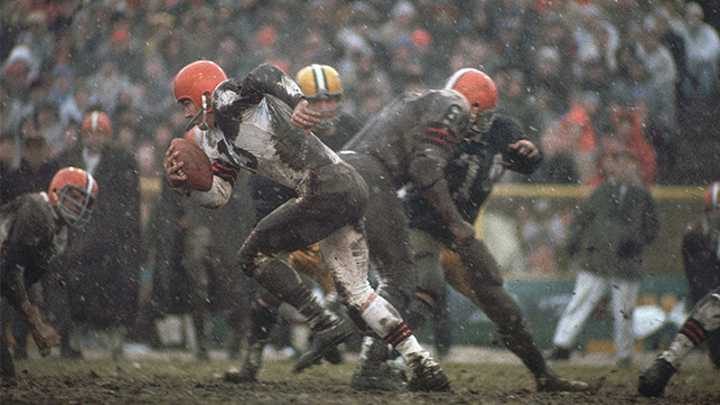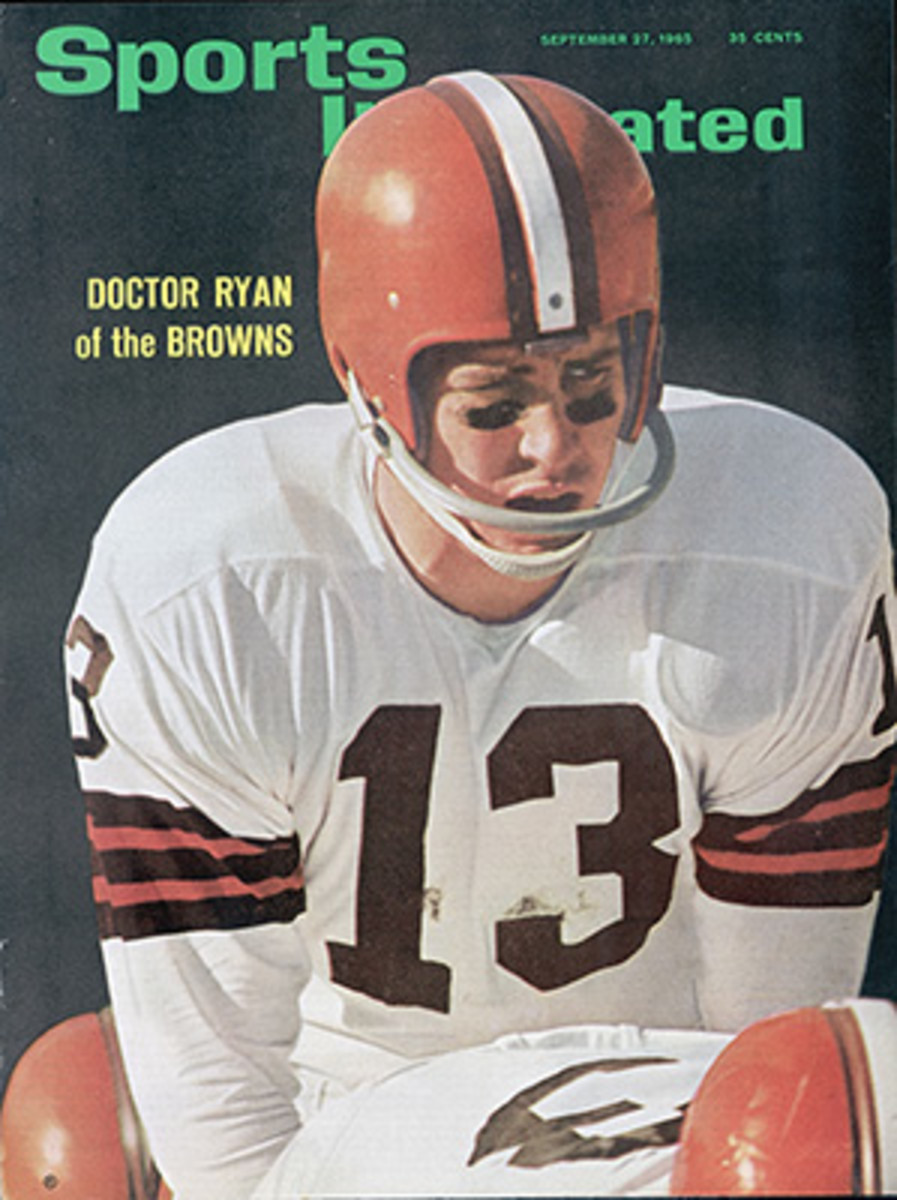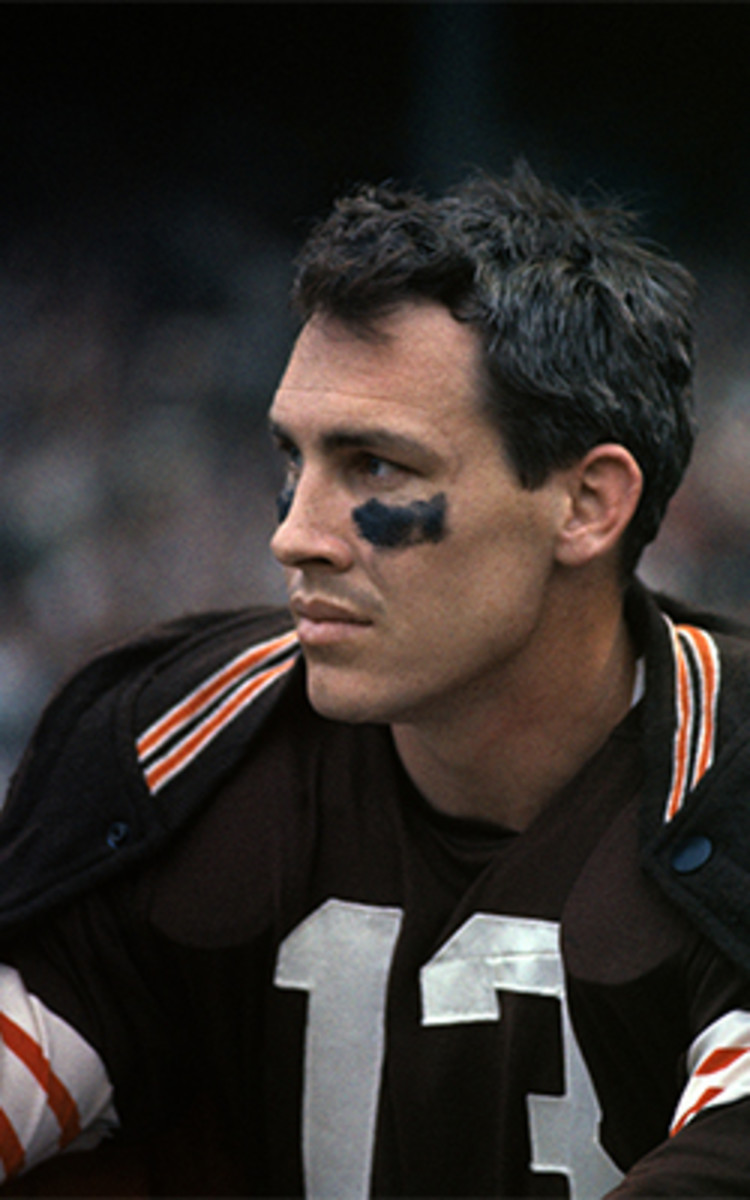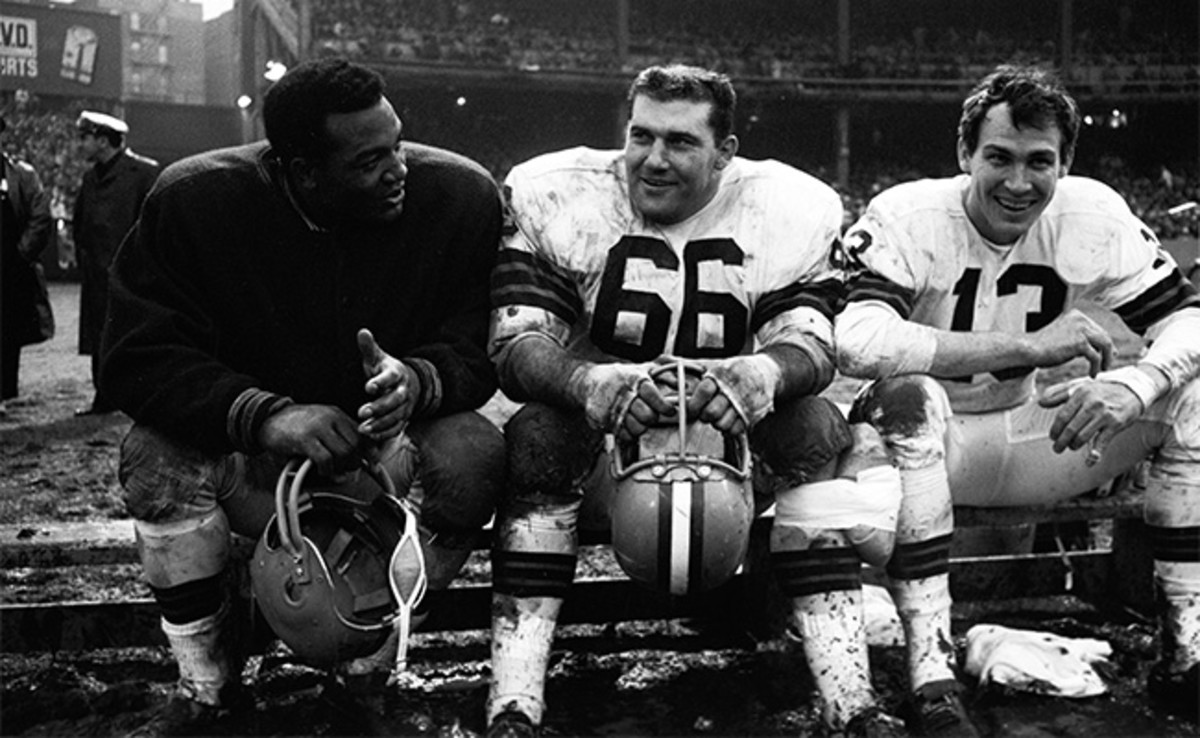Talking Football with the Browns’ Last QB to Win a Championship

Last week, The MMQB looked back on the 1967 NFL season and told stories about what professional football was like 50 years ago. This week, we’re spotlighting the mental side of the game in our Smarter Football series. The subject for this week’s Talking Football sits in the sweet spot of that Venn diagram. Meet Frank Ryan, a 1960s era NFL quarterback who earned his doctorate in mathematics a year after he led the Browns to their most recent NFL Championship (1964). In an age where the majority of players worked offseason jobs, Ryan spent his time working toward his math degree. But he didn’t keep his two worlds entirely separate. Ryan viewed the game with an analytic eye, and tried to get his coaches and teammates to do the same. From his home in Vermont, Ryan, now 80 years old, spoke to The MMQB about his passion for mathematics, his use of advanced statistics that was way ahead of his time, and his memories of his playing career.

KAHLER: Why did you decide to pursue a degree in math while you were playing in the NFL?
RYAN: I got my Ph.D. in my seventh year. It was 1965. We had lost to Green Bay in the NFL Championship Game. Earning my Ph.D. was a way to spend time that is very interesting to me. I had a teaching appointment at Rice, my alma mater, during the offseason. The rest of my teammates worked jobs in the offseason—I can’t imagine any of them being as stupid as me and going back to school. It wasn’t their style. But it was really my style because I had encountered these invisible problems in mathematics that I wanted to be part of.
KAHLER: Working another job in the offseason was standard practice for guys in your era . . .
RYAN: There was no money back then. I can laugh about it. I think anybody who is interested in education and has specialized some of their thinking about these things would welcome having an opportunity to do it during the offseason. It’s very good for the psyche of the person, and occasionally you get lucky and solve some problem that is interesting and helps other people.

KAHLER: Did any of your students at Rice recognize you for being an NFL player?
RYAN:That never happened. I’m sure somebody must have known, but I never mentioned it and nobody ever said anything. Those were the good old days when nobody cared much about professional football.
KAHLER: Your dissertation was titled, A Characterization of the Set of Asymptotic Values of a Function Holomorphic in the Unit Disc.Can you explain that so I can understand it?
RYAN:Well, first of all, I have forgotten it, but it had to do with explaining how a certain type of mathematical entity spread itself out and overlaid itself. I’d have to get it out and read it again to see it. I’ve got a box full of a number of articles that I had written. I do have new ideas in mathematics now, which I am pursuing.
KAHLER: So you still do math regularly?
RYAN: Oh, absolutely. The one thing I am focused on is a very interesting and unknown result of the twin prime conjecture. So, 5 and 7 are primes and there is one number in between them, so you would say that 5 and 7 are a pair of primes. They constitute a twin pair, twin primes, so the question is: Are there an infinite amount of these or does it stop some point? That’s been a problem for about 200 years. I work on that. Every day I think about it. I have a couple of wonderful ideas that I constantly work on. Who knows?
KAHLER: Have you ever solved a big problem similar to the twin prime conjecture in your mathematics life?
RYAN: No, I have never conquered anything that was really big. I never tried really. This is my first try. I didn’t start trying on it until three or four years ago. I was doing a talk at a university and I got off on an angle that I thought was interesting that had to do with the twin prime conjecture. I started about three years ago, and I was trying to think about how this thing should work or not work, and I’ve actually made some pretty good progress. I’m excited about it. Not a day that passes where I don’t stop and think a little bit about this thing.
• TOM TAYLOR: Football’s Next Frontier—The Battle Over Big Data
KAHLER: Have you heard of John Urschel, the Ravens offensive lineman who is getting his Ph.D. right now from MIT?
RYAN: How wonderful, I didn’t know that. I didn’t know he was in mathematics, but more power to him.
KAHLER: As a quarterback, did you ever think about math on the field? The angle of the routes? Force of a hit?
RYAN: Unless we were well ahead in the game, I wouldn’t have brought mathematics into play while I was on the field. Even then I just didn’t really do it. I was dedicated to football and I enjoyed it immensely, and the fact that I was somewhat successful is very pleasing and makes me feel good even today.

KAHLER: In a 1965 article in Sports Illustrated, you were quoted as saying, “It's absolutely false to pursue any sort of notion that football and mathematics are related.” Do you still believe that?
RYAN: Did I say that? I think it’s true. They are just two different aspects of life. Of course, there is some numeric numbering of the conditions in football, like you’ve got to go 10 yards to make a first down, so there is always a little number theory there, but it is not intended to be anything but simplicity in football. Mathematics in football is simplistic.
• ALBERT BREER: Analytics and the NFL—Finding Strength in Numbers
KAHLER: While you played in the NFL, you often kept several games of chess going by mail with people around the country. Did your opponents know you were an NFL player?
RYAN: I don’t think so. I never exploited that stuff. Chess by mail really slows you down. I haven’t played chess for quite a long while, but with the computers that we have nowadays, you can have a very quick activity in a computerized game. But I think that game is a wonderful game and I’ve never really tried to become a champion or anything like that. You have to decide what you want to spend time doing.
KAHLER: Toward the end of your football career, you started learning computer programming, and applied what you knew to football. What kind of statistics were you compiling and how were they different from what was around at the time?
RYAN: I think it had a lot to do with the way the opposing team lined up. I was interested in the positions and locations of players on the other side, and which plays would have more success based on the information about where the defense lined up. I did that stuff for a while. God, I wonder if I have some books about that around here still? I didn’t really dwell on it or depend on it. But in the process of doing it, I automatically picked up on a few tips.
KAHLER: Did you ever share your findings with your teammates? Hey, if the defense is showing Cover 2…
RYAN: Occasionally I would do something like that and then have statistics that I had to work up that constituted a way of thinking about something special. Yes, I would tell them. It didn’t happen regularly, but in between other things.
• ANDY BENOIT: Every NFL Play Is a Brutal Game of Chess
KAHLER: In 1969, you signed with Washington and head coach Vince Lombardi, who embraced your research. How did Lombardi support your advanced statistics?
RYAN: Lombardi hired an occasional person to help me while I was off playing football. I would get back that night and have the stuff all set up. I think Lombardi paid me a little extra money but not much. He did buy some equipment, several computers. He was just about the best head coach that ever existed and he was very aware that the more detail you had—if you could measure something that happened over and over again—that was an advantage for him to know about. He was terribly nice to me. I had gotten hurt in ’66, and so ’68 comes along and that was my last year with Cleveland. I couldn’t play very well at all and they tried to trade me and nobody would take me until I got a call from Coach Lombardi. He gave me a really big salary and I was second-string, I wasn’t even the first-string. He believed in the same sorts of things that I believed in. I was only there for two years, my 12th and 13th years playing professional football. Lombardi died in the offseason between my two years there. I was terribly sad about that and I just decided I’m not going to stay in this thing anymore.
KAHLER: So Lombardi got a two-for-one deal with you, since you could run a two-man analytics department and play quarterback...
RYAN: I think he liked that. He was interested in the computer. He did pay some money to fund it for it to be done properly.

KAHLER: Was Washington a more welcoming environment for advanced statistics than Cleveland had been?
RYAN: Absolutely. That was sort of a new way of looking at football data and coaches had for a long time, had sort of kept up with the data by pencil and paper. This was a big step in the direction of knowing better how football is played. I thought Lombardi was one of the great ones. The Packers had beaten us [the Browns] in 1965 in the overall championship game for that year. I always blamed him for being smarter than we were. When we went up for that game, it was late December, and there was snow the night before. They had a process that left the snow on the field until just before the game started, so they got the field cleared of the snow, yet it was mucky. I think I completed my first three passes in that game, the third one going for a touchdown, but after that I threw the ball behind me more than I threw it in front of me. The ball would slip out of my hands and the place became a quagmire. I think we would have won if we had a normal field to play on. It really was bothersome and disappointing, but that’s the way life is, isn’t it? I can still laugh about it.
KAHLER: What is it like to know you are still the most recent championship quarterback in Cleveland?
RYAN: Isn’t that awful? That was 53 years ago. I sometimes have put myself in the position, if I were there and I could make the decisions, what would I do? That happened more right after I was done, I don’t think about them now. I think it is very disappointing. There are so many nice things about Cleveland. You don’t expect to win every year, but maybe every 10 years. Or maybe every 50! I think it has a lot to do with the attitude of coaches as well as players. If you have the wrong attitude, things get really bad.

KAHLER: You had some great players around you on offense the year the Browns won the 1964 NFL Championship. Jim Brown at fullback, Paul Warfield at receiver…
RYAN: Jim Brown, ah, he was the all-time running back. He wanted to throw the ball, but he couldn’t throw very well. He kept trying to get me to run a play that would set him up from the right side or the left side, and then he would throw the ball. He actually did that pretty well and got [three] touchdown passes over his career. He was such a good athlete that you would expect him to be successful throwing a football, but his throws weren’t what I would call NFL-quality.
Paul was very fast and very smooth, he looked beautiful running here, there and yonder, making sharp cuts and stops—and he got his share of passes that’s for sure. His counterpart, who was five or six years older than him, was Gary Collins. Gary was the right side, Paul was the left side. But they both caught a lot of touchdown passes and I think I had a fairly unique situation because with Jim Brown being the running back that he was, I didn’t have to throw that many passes—yet I did throw a lot of touchdown passes. I think that had a lot to do with the concept of football we had then, we took advantage of the defense having to take care of Jim Brown as their No. 1 thing in the game and while they were taking care of him, I threw the ball down the field. Those were the good old days.
KAHLER: After you retired, you went to work for the U.S. House of Representatives, who hired you to lead the House’s transition into the computer age. What drew you to that job, instead of continuing to grow football analytics?
RYAN: I was interested in how they worked, these members of Congress, and I was building a computer system for the whole House and Senate, so a lot of people got interested in it. It reminded me a little bit of getting into a football game, where there were some complexities to it, the way the defense was working and all that stuff. It was the first computer system that got running throughout the entire place and people were interested in it. With respect to computers in those days, most people didn’t have any real feelings about them, but in football computers were pretty standard, though not as prevalent as they are now, and it was an important methodology that grew and grew during that period and even now.
• ALBERT BREER: How All 32 NFL Teams Handle Analytics
KAHLER: You’ve received a possible Alzheimer’s diagnosis from your doctor. Does that impact your ability to do math?
RYAN: So far it hasn’t gotten in the way of my mathematics. I have a terrible memory now, that is one of my irritations. What happens is, I will try to say a word, and all of a sudden I forget what the word is. And then out of the blue it works in your brain again and that word comes back. I have a wonderful book written by doctors who are interested in mental conditions and how they work and why they work. But it has one fault. It can’t explain why this stuff happens. I am interested in that, because sometimes I think there could be something mathematic to do that would help my mental condition.
KAHLER: Because of your age (80), it might be difficult to determine if playing football had an impact in your possible Alzheimer’s diagnosis. But do you think it may have played a role?
RYAN: Oh absolutely. I got knocked out a number of times, I mean literally knocked out. It was the great delight of everyone on the defensive team to knock the heck out of the quarterback. My body is pretty well beat up too, I had seven or eight operations during my football years. But I feel really good. I am happy, I am able to be alert and do math.
KAHLER: Do you follow the NFL today?
RYAN: No, I moved on. I had several seats out at the stadium out in D.C. but after awhile I got really sort of bored with the games. I don’t watch television football. There’s too much else to do in the world.
KAHLER: Too many math problems to solve!
RYAN: You’ve got a point.
Question? Comment? Story idea? Let us know at talkback@themmqb.com
